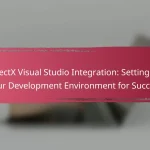Advanced DirectX Graphics Rendering Techniques encompass a range of sophisticated methods designed to produce high-quality visual graphics in applications, particularly in gaming and simulations. Key techniques include tessellation for enhanced surface detail, shadow mapping for realistic shadows, and advanced lighting models like physically based rendering (PBR). The article also addresses the challenges developers face, such as high computational demands, optimization across various hardware, and maintaining real-time performance. Future trends highlighted include real-time ray tracing, machine learning integration for resource optimization, and improved support for virtual and augmented reality, emphasizing the importance of cross-platform compatibility in modern graphics rendering.

What are Advanced DirectX Graphics Rendering Techniques?
Advanced DirectX Graphics Rendering Techniques refer to sophisticated methods used to create high-quality visual graphics in applications. These techniques include features such as tessellation, which enhances surface detail by subdividing polygons. Another method is shadow mapping, which produces realistic shadows in 3D environments. Advanced lighting models, such as physically based rendering (PBR), simulate real-world lighting interactions. Additionally, post-processing effects like motion blur and depth of field enhance the visual experience. These techniques leverage the capabilities of DirectX to achieve high-end visuals in games and simulations. They are essential for rendering complex scenes with realism and detail.
How do Advanced DirectX Graphics Rendering Techniques enhance visual quality?
Advanced DirectX graphics rendering techniques enhance visual quality through improved realism and detail. These techniques utilize advanced shading models, such as physically-based rendering (PBR). PBR simulates how light interacts with surfaces, producing more accurate reflections and textures. Techniques like tessellation increase the geometric detail of surfaces, creating smoother and more complex shapes.
Additionally, real-time ray tracing provides dynamic lighting and shadow effects. This enhances depth and realism in scenes by accurately simulating how light behaves. Post-processing effects, such as ambient occlusion and bloom, further enrich visual fidelity. These effects add depth and highlight details, making scenes more immersive.
Together, these techniques elevate the overall graphical experience, resulting in stunning visuals that engage users.
What specific attributes define high-end visuals in rendering?
High-end visuals in rendering are defined by attributes such as realism, detail, and dynamic lighting. Realism involves accurately simulating physical phenomena like reflections and refractions. Detail is characterized by high-resolution textures and complex geometries. Dynamic lighting enhances the scene by adjusting illumination based on environmental changes. Additionally, advanced shading techniques like ray tracing contribute to visual fidelity. Anti-aliasing methods improve image smoothness by reducing jagged edges. High frame rates ensure fluid motion, enhancing the overall viewing experience. These attributes collectively create immersive and visually stunning graphics.
How do these techniques differ from traditional rendering methods?
Advanced DirectX graphics rendering techniques differ from traditional rendering methods primarily in their efficiency and visual fidelity. These techniques utilize advanced algorithms and hardware acceleration to achieve real-time rendering with higher detail. Traditional methods often rely on rasterization, which can be slower and less capable of handling complex lighting effects. In contrast, advanced techniques incorporate ray tracing and global illumination, resulting in more realistic shadows and reflections. For example, ray tracing can simulate light interactions more accurately than rasterization. This leads to enhanced realism in scenes, particularly in dynamic environments. Additionally, advanced techniques leverage modern GPUs to parallelize tasks, significantly speeding up the rendering process compared to traditional methods.
What are the key components of Advanced DirectX Graphics Rendering Techniques?
The key components of Advanced DirectX Graphics Rendering Techniques include shaders, textures, and rendering pipelines. Shaders are programs that run on the GPU to control the rendering process. They manipulate vertex and pixel data to achieve visual effects. Textures provide surface detail and color information for 3D models. They enhance realism by simulating complex surfaces. Rendering pipelines define the sequence of operations to convert 3D models into 2D images. This process includes stages like vertex processing, rasterization, and pixel shading. Together, these components enable high-quality graphics in real-time applications.
What role does the graphics pipeline play in rendering?
The graphics pipeline is essential in rendering as it processes and transforms 3D models into 2D images. It consists of several stages, including vertex processing, rasterization, and fragment processing. Each stage performs specific tasks to ensure accurate rendering.
Vertex processing transforms 3D coordinates into screen space. Rasterization converts the processed vertices into fragments. Fragment processing determines the color and depth of each pixel.
The graphics pipeline allows for efficient handling of complex scenes. It optimizes performance by parallelizing tasks across the GPU. This structure is critical for achieving high-quality visuals in real-time applications.
How do shaders contribute to advanced rendering techniques?
Shaders enhance advanced rendering techniques by allowing for programmable control over the graphics pipeline. They enable developers to define how vertices and pixels are processed. This results in more complex visual effects, such as realistic lighting and shadowing. Shaders facilitate techniques like bump mapping and reflections, enriching the visual fidelity of 3D scenes. They also optimize performance by offloading computations to the GPU. The use of shaders allows for dynamic changes in materials and textures during rendering. This adaptability leads to more immersive and visually appealing graphics. Overall, shaders are essential for achieving high-end visuals in modern graphics applications.
How are Advanced DirectX Graphics Rendering Techniques applied in various industries?
Advanced DirectX graphics rendering techniques are applied in various industries to enhance visual experiences. In the gaming industry, these techniques provide realistic graphics and immersive environments. This leads to higher player engagement and satisfaction. The film industry utilizes these techniques for visual effects and animation. This enhances storytelling through stunning imagery. In architectural visualization, these techniques create detailed 3D models of buildings. This aids in client presentations and design processes. The automotive industry employs these techniques for virtual prototyping and simulation. This reduces development costs and time. Lastly, in healthcare, advanced rendering techniques visualize complex medical data. This improves diagnostics and surgical planning. Each application demonstrates the versatility and impact of DirectX rendering techniques across sectors.
What are the primary use cases in gaming development?
The primary use cases in gaming development include graphics rendering, physics simulation, artificial intelligence, and networked multiplayer functionality. Graphics rendering is essential for creating high-quality visuals using techniques like DirectX. Physics simulation enhances realism by accurately modeling physical interactions in the game environment. Artificial intelligence is used to create responsive and adaptive non-player characters. Networked multiplayer functionality enables players to interact in real-time across different locations. These use cases are crucial for delivering immersive gaming experiences.
How do these techniques impact film and animation production?
Advanced DirectX graphics rendering techniques significantly enhance film and animation production. These techniques improve visual fidelity and realism in digital content. They allow for more detailed textures, dynamic lighting, and realistic shadows. Enhanced graphics rendering can lead to more immersive storytelling experiences. Techniques such as ray tracing provide accurate reflections and refractions. This results in a higher quality visual output. Additionally, real-time rendering capabilities speed up the production process. Faster rendering reduces the time needed for post-production editing. Overall, these advancements elevate the artistic quality of films and animations.

What are the challenges associated with Advanced DirectX Graphics Rendering Techniques?
The challenges associated with Advanced DirectX Graphics Rendering Techniques include high computational demands. These techniques require significant processing power and memory bandwidth. This can lead to performance bottlenecks on less powerful hardware. Additionally, optimizing rendering for various hardware configurations can be complex. Developers often face difficulties in achieving consistent visual quality across different devices. Debugging advanced rendering techniques can also be challenging due to their complexity. Furthermore, maintaining real-time performance while implementing advanced effects is often a trade-off. Lastly, keeping up with rapid advancements in graphics technology poses an ongoing challenge for developers.
What technical limitations do developers face?
Developers face several technical limitations in advanced DirectX graphics rendering. These limitations include hardware constraints, such as GPU capabilities and memory bandwidth. Many graphics cards may not support the latest DirectX features, restricting developers’ ability to implement cutting-edge techniques. Additionally, performance issues arise from rendering high-resolution textures and complex shaders, which can lead to frame rate drops. Compatibility with various operating systems and devices also presents challenges. Developers must optimize their code to ensure smooth performance across different hardware configurations. Limitations in development tools can hinder the efficiency of the rendering process. Finally, the complexity of managing multiple rendering pipelines can complicate development workflows.
How do hardware requirements affect rendering performance?
Hardware requirements significantly influence rendering performance. High-performance GPUs accelerate image processing and reduce rendering times. CPUs also play a crucial role in handling complex calculations. Sufficient RAM ensures smooth data handling during rendering tasks. For instance, a system with a powerful GPU can render high-resolution textures faster than one with a weaker GPU. Additionally, storage speed impacts loading times for assets. Solid-state drives (SSDs) provide quicker access compared to traditional hard drives. Overall, meeting or exceeding hardware specifications leads to improved rendering efficiency and visual quality.
What common pitfalls should developers avoid?
Developers should avoid common pitfalls such as neglecting performance optimization. Performance issues can arise from inefficient rendering techniques. Failing to profile the application can lead to undetected bottlenecks. Overusing complex shaders can also degrade performance significantly. Ignoring hardware limitations may result in poor user experiences. Not considering cross-platform compatibility can lead to inconsistencies in graphics rendering. Developers should also avoid hardcoding values, as this reduces flexibility. Lastly, inadequate testing can result in undetected bugs that affect visual quality. These pitfalls can hinder the effectiveness of advanced DirectX graphics rendering techniques.
How can developers optimize their use of Advanced DirectX Graphics Rendering Techniques?
Developers can optimize their use of Advanced DirectX Graphics Rendering Techniques by implementing efficient resource management. This includes minimizing state changes and reducing draw calls, which can significantly enhance performance. Using techniques like instancing allows rendering multiple objects with a single draw call, improving efficiency.
Optimizing shaders is also crucial. Developers should ensure that shaders are lightweight and avoid complex calculations within pixel shaders when possible. Profiling tools can help identify bottlenecks in rendering performance.
Additionally, leveraging DirectX features such as Direct3D 12’s low-level access can lead to better CPU and GPU utilization. Developers should also consider using asynchronous compute to maximize hardware capabilities.
Finally, employing level of detail (LOD) techniques can reduce the rendering workload by adjusting the complexity of 3D models based on their distance from the camera. These strategies collectively contribute to smoother and more visually appealing graphics in applications.
What best practices should be followed for performance enhancement?
To enhance performance in advanced DirectX graphics rendering, implement efficient resource management. Optimize texture sizes to reduce memory usage. Use mipmapping to improve rendering speed and reduce aliasing. Minimize state changes during rendering to decrease overhead. Batch draw calls to reduce CPU-GPU communication. Utilize instancing to render multiple objects efficiently. Profile performance regularly to identify bottlenecks and optimize accordingly. These practices can lead to significant improvements in rendering performance and visual quality.
How can developers troubleshoot common rendering issues?
Developers can troubleshoot common rendering issues by systematically isolating the problem. First, they should check for syntax errors in the code. Tools like debuggers can help identify these errors. Next, verifying graphics drivers is crucial. Outdated drivers can lead to rendering problems.
Additionally, developers should examine the rendering pipeline. They need to ensure that all stages are functioning correctly. Using diagnostic tools can help pinpoint where the issue occurs. Testing on different hardware configurations can also reveal compatibility issues.
Lastly, reviewing the documentation for APIs like DirectX is essential. This can provide insights into known issues and their solutions. By following these steps, developers can effectively address rendering issues in high-end visuals.

What future trends are emerging in Advanced DirectX Graphics Rendering Techniques?
Future trends in Advanced DirectX Graphics Rendering Techniques include increased use of real-time ray tracing. This technique enhances lighting and shadows in graphics. Machine learning is also being integrated to optimize rendering processes. This allows for more efficient resource management and improved visual fidelity. Another trend is the adoption of Variable Rate Shading. This enables developers to allocate shading resources more effectively. Enhanced support for virtual reality and augmented reality is emerging as well. This ensures smoother experiences and higher frame rates. Finally, there is a focus on cross-platform compatibility. This trend allows developers to create more versatile applications across different devices.
How is real-time ray tracing shaping the future of rendering?
Real-time ray tracing is revolutionizing rendering by providing realistic lighting and shadows. This technology simulates the way light interacts with objects in a scene. It enhances visual fidelity in video games and simulations. With ray tracing, reflections and refractions are more accurate than traditional rasterization methods. This leads to immersive experiences for players and users. According to NVIDIA, real-time ray tracing can achieve cinematic quality visuals. The introduction of dedicated hardware, like NVIDIA’s RTX series, accelerates this process. As more developers adopt this technology, the standard for graphics quality continues to rise. Real-time ray tracing is set to define the future of high-end visual rendering.
What advancements in hardware are influencing rendering techniques?
Advancements in hardware significantly influence rendering techniques. Graphics Processing Units (GPUs) have evolved to support real-time ray tracing. This technology enhances lighting and shadow effects in visual rendering. Modern GPUs also incorporate AI-driven features for image upscaling and denoising. These capabilities improve rendering speed and visual fidelity. Moreover, increased VRAM allows for handling larger textures and more complex scenes. The introduction of hardware-accelerated features in APIs like DirectX 12 further optimizes performance. Collectively, these advancements lead to more immersive and realistic graphics in high-end visuals.
What practical tips can enhance the use of Advanced DirectX Graphics Rendering Techniques?
Utilizing advanced DirectX graphics rendering techniques can be enhanced through several practical tips. First, optimize your shaders for performance. This reduces the computational load on the GPU. Second, leverage hardware instancing to draw multiple objects with a single draw call. This minimizes CPU overhead and improves rendering speed. Third, implement level of detail (LOD) techniques to decrease the polygon count for distant objects. This improves frame rates without sacrificing visual quality. Fourth, use occlusion culling to avoid rendering objects not visible to the camera. This saves processing power. Fifth, ensure efficient texture management by using texture atlases. This reduces the number of texture switches during rendering. Lastly, profile your application regularly to identify bottlenecks. Tools like PIX for Windows can provide insights into performance issues. These strategies collectively enhance the efficiency and quality of graphics rendering in DirectX applications.
How can developers stay updated with the latest DirectX features?
Developers can stay updated with the latest DirectX features by regularly checking the official Microsoft DirectX blog. This blog provides announcements, tutorials, and updates on new features. Additionally, developers should follow the DirectX developer community on platforms like GitHub and Discord. These platforms often share insights and discussions about recent changes and best practices. Participating in forums and attending industry conferences also helps developers gain knowledge on DirectX advancements. Microsoft frequently updates its documentation, which is another essential resource for developers. Following relevant social media accounts can also provide timely updates and information.
What resources are available for learning advanced rendering techniques?
Online courses such as Coursera and Udemy offer structured learning for advanced rendering techniques. Books like “Real-Time Rendering” provide in-depth theoretical knowledge. Tutorials on platforms like YouTube cover practical applications and software-specific techniques. Documentation from rendering engines such as Unreal Engine and Unity includes advanced rendering guides. Forums and communities like Stack Overflow and CGSociety facilitate peer learning and problem-solving. Conferences and workshops, such as SIGGRAPH, present cutting-edge research and networking opportunities. These resources collectively enhance understanding and skill in advanced rendering techniques.
Advanced DirectX Graphics Rendering Techniques encompass a range of sophisticated methods designed to enhance visual quality in applications, primarily through improved realism and detail. Key attributes defining high-end visuals include dynamic lighting, advanced shading models, and post-processing effects, which collectively elevate the graphical experience in gaming, film, and various industries. The article explores the distinctions between advanced and traditional rendering methods, the critical components of the graphics pipeline, the challenges developers face, and future trends such as real-time ray tracing. Additionally, it provides practical tips for optimizing rendering performance and staying updated on DirectX advancements.


